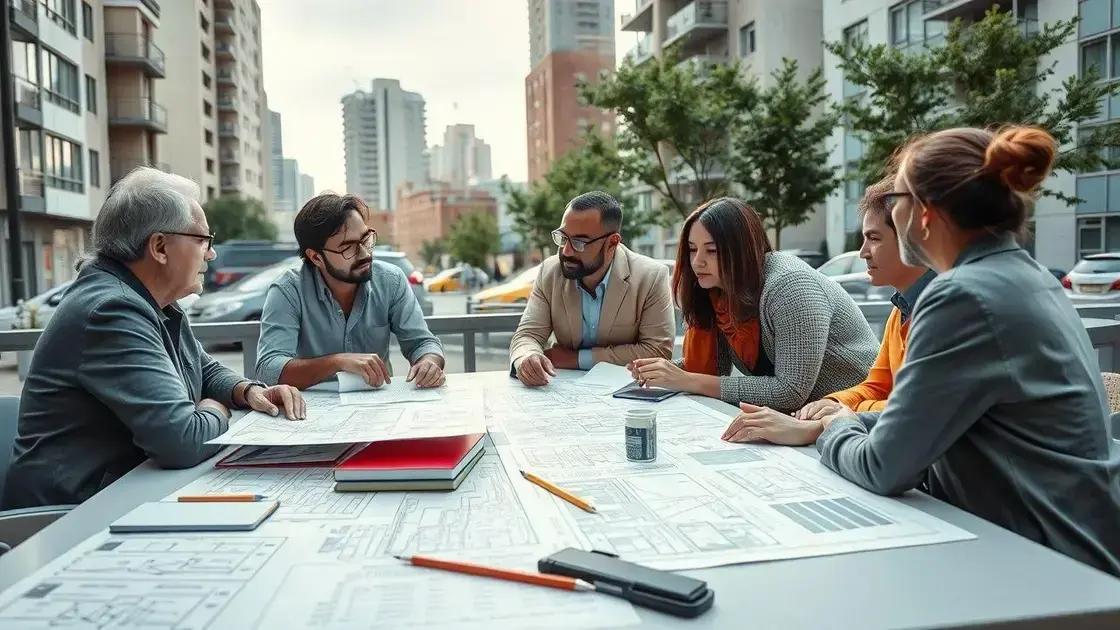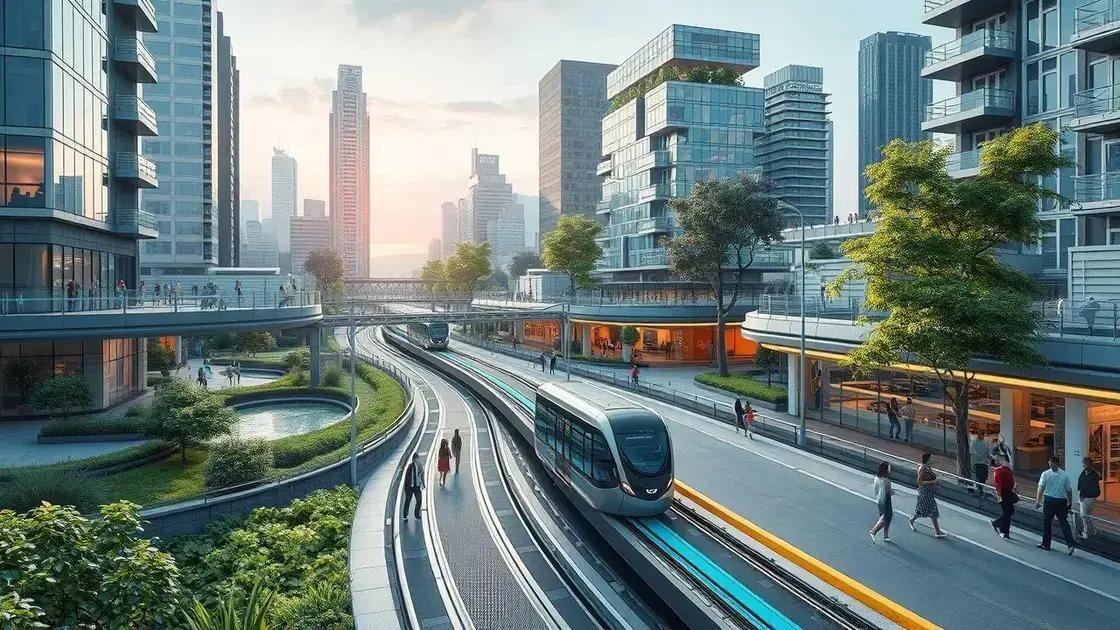Infrastructure development plans: unlock your city’s potential

Infrastructure development plans are essential for enhancing urban living, focusing on community needs, incorporating sustainable practices, and utilizing smart technologies to create efficient and resilient urban environments.
Infrastructure development plans play a pivotal role in shaping the future of our cities. What if you could influence these plans with your thoughts and needs? Let’s explore how these initiatives can improve our daily lives and communities.
Understanding the importance of infrastructure development
Understanding the importance of infrastructure development is essential for any community aiming to grow and thrive. Infrastructure forms the backbone of our cities, impacting everything from transportation to economic opportunities.
When we talk about infrastructure development, we refer to the systems and facilities that support everyday life. This includes roads, bridges, schools, hospitals, and more. These elements are crucial in creating a well-functioning community.
The role of infrastructure in economic growth
One key factor is that strong infrastructure can directly boost the economy. Businesses rely on efficient transportation and communication networks to operate effectively. When roads and services are improved, it leads to an increase in trade and investment.
- Attracts new businesses to the area
- Enhances job creation
- Increases property values
Moreover, investing in infrastructure can lead to significant job opportunities. Construction and maintenance projects often require a skilled workforce, providing jobs for local residents.
Enhancing quality of life
Additionally, well-developed infrastructure improves the quality of life. Access to reliable public transportation, safe roads, and clean water are basic needs for any community. When these services are available, residents experience less stress and can focus on their daily lives.
Not to mention, quality infrastructure encourages community engagement. Parks, recreational facilities, and community centers create spaces for people to come together and connect.
- Encourages social interactions
- Improves public health
- Promotes local culture and events
All these factors highlight the vital role that infrastructure development plays in fostering successful communities. Without investment in these areas, cities can struggle to meet the needs of their residents.
Ultimately, the importance of infrastructure development cannot be overstated. By understanding its far-reaching effects, communities can prioritize their needs and advocate for better resources.
Key components of effective development plans

Key components of effective development plans are fundamental to ensuring that infrastructure projects meet the needs of the community. These components help in creating a roadmap that balances growth, sustainability, and quality of life.
One major aspect is the project scope. This defines what the project aims to achieve, detailing services, facilities, and specific objectives. An accurate scope ensures all stakeholders understand the goals and deliverables.
Stakeholder engagement
Stakeholder engagement is another vital component. This process involves connecting with those affected by the project, including residents, businesses, and local governments. Engaging stakeholders early leads to better outcomes.
- Gather feedback and insights
- Build trust and transparency
- Encourage community support
Moreover, robust budgeting is essential for development plans. A well-structured budget accounts for all costs and helps manage resources effectively. This includes construction costs, maintenance, and unforeseen expenses.
Data analysis and research
Incorporating data analysis and research into the planning process is also crucial. Gathering data on demographics, traffic patterns, and existing infrastructure helps planners make informed decisions. This research informs the prioritization of projects based on community needs.
- Identify areas needing improvement
- Analyze trends and forecasts
- Assess environmental impacts
Moreover, the commitment to sustainable practices should not be overlooked. Integrating eco-friendly solutions into development plans ensures that projects do not harm the environment and promote long-term sustainability.
These key components work together to create effective development plans. Without them, projects risk falling short of their objectives, leading to wasted resources and diminished community benefits.
How to engage the community in planning
How to engage the community in planning is a vital aspect of successful infrastructure development. Involving the community not only fosters trust but also ensures that the needs and preferences of residents are addressed.
One effective method for community engagement is through public meetings. These gatherings allow residents to voice their opinions and provide valuable feedback on proposed infrastructure projects. It’s essential to create a welcoming environment where everyone feels encouraged to participate.
Using surveys and questionnaires
Another approach is to utilize surveys and questionnaires. These tools can gather data from a broader audience, ensuring that even those who cannot attend meetings have a chance to express their views. An effective survey should be clear and concise, focusing on specific aspects of the project.
- Ask about priorities and needs
- Gauge community interest in different options
- Maintain anonymity to encourage honest responses
Social media platforms are also powerful tools for engaging the community. By sharing project updates and soliciting feedback online, planners can reach a larger audience. Regular posts can keep the community informed and interested.
Collaborative workshops
Collaborative workshops are an excellent way to involve community members directly in the planning process. These sessions can encourage brainstorming and discussions, allowing participants to contribute ideas and solutions. Involving residents in developing plans creates a sense of ownership.
- Promote teamwork and creativity
- Incorporate diverse perspectives and ideas
- Build stronger community relationships
Additionally, it’s important to keep communication open throughout the project. Regular updates help maintain community involvement and show residents that their input is valued. Transparency fosters trust and demonstrates a commitment to collaborative planning.
In summary, engaging the community in planning is about creating pathways for dialogue and participation. By utilizing various strategies, planners can ensure that the community feels involved and invested in infrastructure projects.
Funding options for infrastructure projects

Funding options for infrastructure projects are crucial for bringing development plans to reality. Identifying the right sources of funding can determine the success of these initiatives. Various options exist, each with its own benefits and challenges.
One of the primary funding sources is government grants. Many local and federal programs offer financial support for infrastructure projects. These grants typically do not need to be repaid, making them an attractive option for communities.
Public-private partnerships
Another option is to consider public-private partnerships (PPPs). This approach allows the government and private sector to collaborate on infrastructure projects. The private sector can bring expertise and efficiency, while the public sector benefits from shared financial risk.
- Encourages innovation through private investment
- Reduces the financial burden on taxpayers
- Can speed up project completion times
Additionally, local governments might explore bonds as funding instruments. Bonds allow governments to borrow money from investors with the promise of repayment over time. This can be particularly useful for larger projects requiring upfront capital.
Impact fees
Impact fees are another funding mechanism. These fees charge developers for the impact their projects will have on local infrastructure. The collected funds are then allocated to improve roads, utilities, and other necessary services. This ensures that those who benefit from the development also contribute to infrastructure costs.
- Helps maintain infrastructure quality
- Aligns development with community needs
- Can provide a steady revenue stream
Lastly, crowdfunding has gained popularity as a modern funding option. Communities can pool small contributions from many individuals through online platforms. This approach not only raises funds but also fosters community involvement and awareness.
By exploring various funding options, communities can effectively finance their infrastructure projects. Each funding source has unique advantages that can help bring vital developments to life, enhancing the community’s quality of life.
Case studies: Successful infrastructure initiatives
Case studies of successful infrastructure initiatives show how effective planning and community engagement can lead to great outcomes. By examining real-world examples, we can learn valuable lessons about what works and what doesn’t in infrastructure development.
One notable case is the High Line in New York City. This elevated park transformed an old railway line into a vibrant green space for the community. The project engaged local residents and artists, creating a unique public area that attracts millions of visitors each year.
Bartlett Park in Chicago
Another successful initiative is Bartlett Park in Chicago. This community park project included input from residents to design recreational facilities and green spaces that meet the needs of families and children. The park not only enhances community pride but also promotes physical activity among residents.
- Provides a safe environment for children
- Encourages community gatherings and events
- Improves neighborhood aesthetics
The City of Melbourne in Australia has also implemented a successful urban renewal project. The city invested in revitalizing neglected areas through infrastructure improvements, including better public transport and pedestrian pathways. This led to increased economic activity and higher property values.
Green road initiatives
In Seattle, the city launched a green road initiative that focuses on sustainable infrastructure. They incorporated rain gardens, bioswales, and permeable pavement to manage stormwater and reduce flooding. This project not only addresses environmental concerns but also enhances the urban landscape.
- Reduces urban heat islands
- Improves water quality in local streams
- Promotes biodiversity in urban areas
Each of these case studies highlights key elements that contribute to the success of infrastructure projects. From community involvement to sustainable practices, these initiatives serve as a guide for future developments. By analyzing these examples, cities can implement better strategies for their own infrastructure needs.
Future trends in urban infrastructure

Future trends in urban infrastructure are shaping how cities will function in the coming years. Understanding these trends helps communities plan for sustainable growth and development. As urbanization continues, new technologies and ideas will transform our cities.
One major trend is the integration of smart technology into urban infrastructure. Cities are increasingly using sensors, data analytics, and IoT (Internet of Things) devices to manage resources effectively and improve services. Smart streetlights, traffic management systems, and waste collection sensors are just a few examples of this technology in action.
Sustainable design practices
Another important trend is the emphasis on sustainable design practices. Cities are recognizing the need to reduce their carbon footprints and create green spaces. This leads to the development of energy-efficient buildings, green roofs, and permeable pavements that allow for better water management.
- Encourages biodiversity through natural habitats
- Reduces heat islands in urban areas
- Improves air quality for residents
Public transportation systems are also evolving. The push for efficient mass transit options will result in the expansion of bike paths, electric buses, and metro systems. These options provide eco-friendly alternatives to car travel, reducing traffic congestion and greenhouse gas emissions.
Resilience to climate change
Infrastructure will need to adapt to increasing risks from climate change. Cities are focusing on building resilience through flood defenses, heat management strategies, and reliable energy sources. Planning for these challenges means investing in systems that can withstand extreme weather events.
- Implementing green infrastructure to manage stormwater
- Creating heat-resistant public areas
- Enhancing energy grids for stability
Furthermore, community involvement in planning is becoming essential. Citizens want to be part of the decision-making process. Engaging the community helps ensure that infrastructure meets the needs of the people who use it.
Overall, the future of urban infrastructure looks promising. These trends not only focus on improving efficiency and sustainability but also on enhancing the quality of life for all residents.
FAQ – Frequently Asked Questions about Urban Infrastructure Development
What role does smart technology play in urban infrastructure?
Smart technology helps cities improve efficiency by utilizing sensors and data to manage resources and enhance services.
How can communities engage in the planning process?
Communities can engage by attending public meetings, filling out surveys, and participating in collaborative workshops to voice their needs.
What are some sustainable practices in infrastructure development?
Sustainable practices include using eco-friendly materials, creating green spaces, and implementing energy-efficient designs.
How does climate change affect urban planning?
Climate change requires cities to adapt their infrastructure to withstand extreme weather and incorporate resilience measures to mitigate risks.






